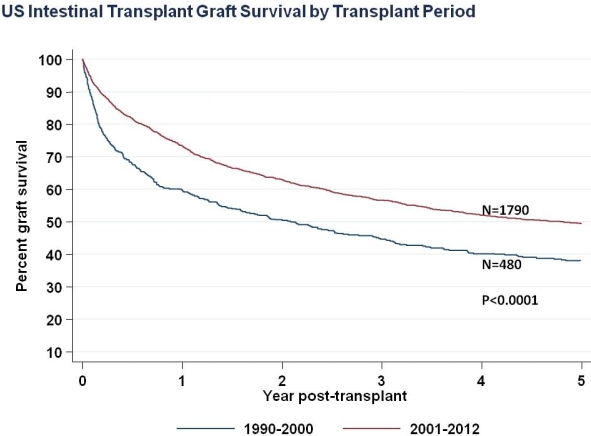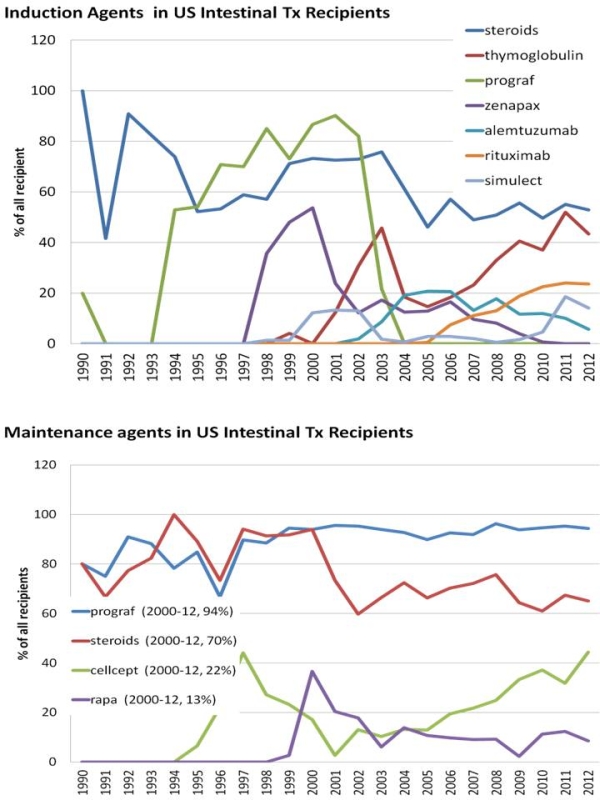Current Status of US Intestinal and Multivisceral Transplantation: An Analysis of the UNOS Intestine Transplant Registry
1Terasaki Foundation Lab, Los Angeles, CA
2Lincoln High School, Stockton, CA
3The 4th Military Medical University, Xi-An, China.
Meeting: 2015 American Transplant Congress
Abstract number: A286
Keywords: Graft survival, Immunosuppression, Induction therapy, Rejection
Session Information
Session Name: Poster Session A: Small Bowel All Topics
Session Type: Poster Session
Date: Saturday, May 2, 2015
Session Time: 5:30pm-7:30pm
 Presentation Time: 5:30pm-7:30pm
Presentation Time: 5:30pm-7:30pm
Location: Exhibit Hall E
The purpose of this study is to analyze the current status of US intestinal transplantation (IT). As of 9/19/2014, 2441 IT have been performed in 46 centers (2400 deceased, 41 living). Eight centers did more than 100 transplants. Annual case numbers peaked in 2007 (n=198) and became steadily decreasing since then to 109 cases in 2013. Short gut syndrome (68%) and functional bowel problem (15%) are two major indications for IT. The 3 major types of transplants involving intestine include isolated intestine transplant (I), simultaneous intestine, liver, and pancreas transplant (I+L+P), and combined intestine and liver (I+L) transplant. The graft survival (GS) has significantly improved in recent years, mainly due to improved 1st year GS. The 1yr, 5yr, and 10yr GS were 74%,42%, &26% (I); 70%, 50%, &40% (I+L+P); and 61%, 46%, & 40% (I+L). The longest GS for I, I+L+P, and I+L were 19 years, 16 years, and 23 years. Steroids, Thymoglobulin, and Rituximab are 3 major induction agents used in recent years. Prograf (92-96%), Steroids (60-76%) and Cellcept (2.7-44%) are 3 major maintenance agents.
The 1yr, 5yr, and 10yr GS were 74%,42%, &26% (I); 70%, 50%, &40% (I+L+P); and 61%, 46%, & 40% (I+L). The longest GS for I, I+L+P, and I+L were 19 years, 16 years, and 23 years. Steroids, Thymoglobulin, and Rituximab are 3 major induction agents used in recent years. Prograf (92-96%), Steroids (60-76%) and Cellcept (2.7-44%) are 3 major maintenance agents. Induction recipients (68%) had a significantly lower acute rejection rates than nonrecipients before discharge (60% vs 75%, p<0.001). Most of the patients received 2 (53%) or 3 (25%) maintenance immunosuppressants. Acute rejection episodes were usually treated with one (60%) or two agents (27%). Steroids were most commonly used (50-60%). OKT3 has been replaced with ATG(1999-) and Rituximab (2006-). In conclusion, annual case numbers of IT have been decreasing regardless of improved GS. Significantly improved GS and reduced acute rejection may be due to, or at least partly due to the application of new immunosuppressive agents.
Induction recipients (68%) had a significantly lower acute rejection rates than nonrecipients before discharge (60% vs 75%, p<0.001). Most of the patients received 2 (53%) or 3 (25%) maintenance immunosuppressants. Acute rejection episodes were usually treated with one (60%) or two agents (27%). Steroids were most commonly used (50-60%). OKT3 has been replaced with ATG(1999-) and Rituximab (2006-). In conclusion, annual case numbers of IT have been decreasing regardless of improved GS. Significantly improved GS and reduced acute rejection may be due to, or at least partly due to the application of new immunosuppressive agents.
To cite this abstract in AMA style:
Cai J, Qing A, Wu G, Everly M, Terasaki P. Current Status of US Intestinal and Multivisceral Transplantation: An Analysis of the UNOS Intestine Transplant Registry [abstract]. Am J Transplant. 2015; 15 (suppl 3). https://atcmeetingabstracts.com/abstract/current-status-of-us-intestinal-and-multivisceral-transplantation-an-analysis-of-the-unos-intestine-transplant-registry/. Accessed January 6, 2026.« Back to 2015 American Transplant Congress
